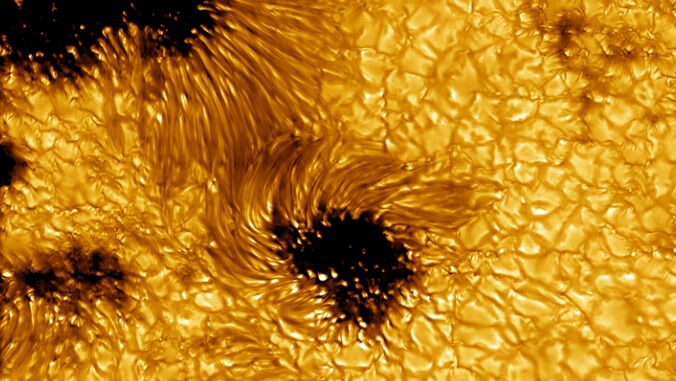
A new era of solar science commenced when the National Science Foundation’s (NSF’s) Daniel K. Inouye Solar Telescope (Inouye Solar Telescope) on Haleakalā conducted its first science observations on February 24—the start of a year-long operations commissioning phase. The telescope is by far the world’s most powerful solar telescope, and stands atop Maui’s majestic 10,000-foot summit.
Favorable atmospheric conditions atop the summit make this the best site, as proven by the National Solar Observatory (NSO) and the University of Hawaiʻi Institute for Astronomy (IfA) during a worldwide survey.
“We are proud to bring the world’s largest and most powerful solar telescope online,” said NSF Director Sethuraman Panchanathan. “The NSF’s Daniel K. Inouye Solar Telescope is a modern technological marvel, named in honor of late Senator Inouye, an American hero and leader dedicated to scientific research and discovery.”
Hailed as the “crowning achievement” for ground-based solar astronomy, the Inouye Solar Telescope utilizes the next generation of solar observing instruments capable of capturing images of the sun in unprecedented detail. The telescope’s operational phase is a long-awaited accomplishment, after an 18-month delay caused by the COVID-19 global pandemic.
The Inouye Solar Telescope will take high-resolution images and make measurements of the magnetic fields of solar phenomena including sunspots, solar flares and coronal mass ejections. Solar activity drives space weather that can impact Earth by disrupting power grids, communication networks and other technologies.
Peering into the Sun

IfA scientists Jeffrey Kuhn and Haosheng Lin constructed two complex infrared instruments for the state-of-the-art facility that will allow scientists to predict the Sun’s magnetic activity and solar storms. The first is called the Cryogenic Near-Infrared Spectropolarimeter. The nearly 2-ton instrument is designed to measure the Sun’s magnetism beyond the visible solar disk. Its early observations confirmed a two-decades-long anticipated infrared solar feature that opens new windows for coronal magnetism measurements.
The second, called the Diffraction-Limited Near-IR Spectropolarimeter (DL-NIRSP), enables researchers to view the evolution of the Sun’s magnetic fields in extreme detail. The instruments are poised to help solve some of the most enigmatic mysteries of the Sun.
“Building the DL-NIRSP has been the most challenging project in my career, and it would not have been possible without the hard work of all the members of the instrument team, including scientists and engineers from both UH and NSO,” said Lin. “We were excited to see the first science verification data during the commission phase of the project, and we cannot wait to see it start the regular science observations in the coming months.”
- Related UH News story: Never-before-seen images of Sun released from world’s largest solar telescope, January 29, 2020
In 2020, the Inouye Solar Telescope’s “First Light” campaign previewed the powerful optical systems by producing the highest resolution image of the solar surface ever taken, followed six months later by the clearest image ever taken of a sunspot.
The facility combines numerous state-of-the-art systems including a 4-meter primary mirror, adaptive optics to correct for the effects of the atmosphere, active cooling of all telescope optics, and advanced optical and infrared instrumentations. The suite of instruments is capable of many feats, ranging from capturing images of features on the Sun three times smaller than any previously recorded to facilitating regular measurements of the solar corona’s magnetic fields for the first time.
For more information go to the National Science Foundation website.
This research is an example of UH Mānoa’s goal of Excellence in Research: Advancing the Research and Creative Work Enterprise (PDF), one of four goals identified in the 2015–25 Strategic Plan (PDF), updated in December 2020.

